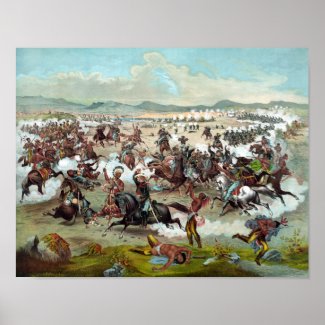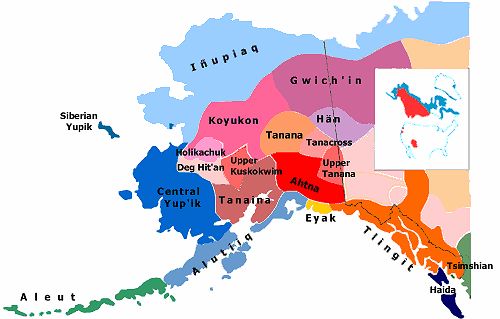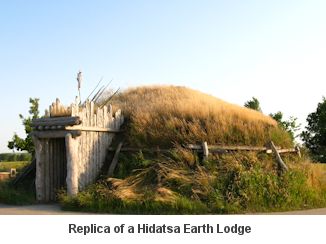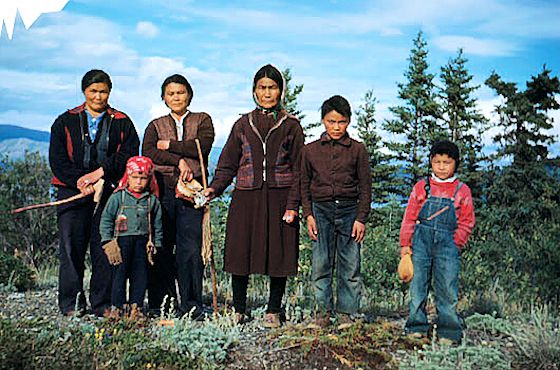The Nez Perce saved the Lewis & Clark expedition multiple times, and are known for their prized appaloosa horses. Here are 10 things you should know about the Nez Perce tribe.
Tribes by Region
Ethnographers commonly classify the native peoples of the United States and Canada into ten geographical regions with shared cultural traits. The following list groups native american indians by their region of origin, followed by the current reservation locations.
A number of legends have grown around the New Madrid Earthquakes of 1811-1812, most notable being a story about the Shawnee chief Tecumseh, who attempted to unify Native American tribes in response to encroachment by white settlers. In September 1811, his efforts were rebuffed at a meeting of southern tribes at Tuckhabatchee. Tecumseh angrily said that, upon returning to his home near present-day Detroit, Michigan, “I will stamp my foot on the ground and shake down every house in Tuckhabatchee.” About the time of his expected return to Detroit, the earthquakes happened.
Cherokee in Arkansas
22 ViewsAt the time of European contact, the Cherokee inhabited a region consisting of what is now western North Carolina and parts of Virginia, Georgia, and eastern Tennessee. Over the next two centuries, the tribe expanded through the southern Appalachians, reaching further into Georgia as well as into South Carolina, northeastern Alabama, and across the Cumberland River into Kentucky and West Virginia; some of this expansion occurred following the displacement of other tribes.
By the 1780s, Cherokee migration into Arkansas had begun, largely in response to pressure to move away from Euro-American settlements in the East following the Revolutionary War.
The historical trauma that my community has experienced is still with us today and manifests itself in the social ills of poverty. Yet, it is the rich culture provided by the wealth of the land and sea that defines the health of our community. Just as in Inupiaq times, when men and women, elders and youth had vital and equally important roles to play in the success of a community, we all have roles today. All of our institutions have roles to play.
History of the Georgia Creek Indians
22 ViewsMissions of California
22 ViewsThe twenty-one Spanish missions in California established by Catholic priests of the Franciscan order between 1769 and 1834, were supposed to expand Christianity among the Native Americans living in the area. The local natives were forcibly relocated from their traditional dwellings, villages, and homelands to live and work at the missions as virtual slaves.
At the start of the Mexican-American War in 1846, many Apache bands promised U.S. soldiers safe passage through their land. When the U.S. claimed the former frontier territories of Mexico in 1848, Mangas Coloradas signed a peace treaty, respecting them as conquerors of the Mexicans’ land.
Ojibwe names, bands, and sub-nations
31 ViewsOjibwe is virtually identical to Ottawa, Potawatomi and Algonkin, with a more distant relationship to the Illinois and Miami. After 1680, Ojibwe became the trade language in the northern Great Lakes because they were the most numerous tribe in the North.
The Minnesota Chippewa Tribe consists of these bands: Bois Forte Band (Nett Lake), Fond du Lac Band, Grand Portage Band, Leech Lake Band, Mille Lacs Band, and White Earth Band. Here are the enrollment requirements for the Minnesota Chippewa Tribe.
August 10, 2015, marked the 335th anniversary of the Pueblo Indian uprising, during which they expelled the Spanish usurpers and tormentors from New Mexico. Modern Pueblo Indians call August 10 Independence Day. While the Spaniards returned and re-subjugated the Puebloans 12 years later, they were able to re-establish and keep their religion and culture, which have endured to this day. No other Native American uprising as successful as the Pueblo Revolt happened before or after.
Unangan (Aleut) Heritage
22 ViewsSeveral thousand years ago, before European explorers discovered the shores of the Aleutian Islands, they were inhabited by the “Unangas” (Aleut people).
Alaska Northwest Coast Cultures
25 ViewsThe Eyak, Tlingit, Haida and Tsimshian share a common and similar Northwest Coast Culture with important differences in language and clan system.
Prior to the early 18th Century, most of Georgia was home to American Indians belonging to a southeastern alliance known as the Creek Confederacy. Today’s Creek Nation, also known as the Muskogee, were the major tribe in that alliance.
The Tlingit are a tribe, people and culture that are indigenous to the United States. They have owned and occupied Southeast Alaska since time immemorial. They are a federally recognized region-wide tribe under the Central Council of Tlingit and Haida Indian Tribes of Alaska. In addition, thirteen Tlingit communities within the Southeast region are federally recognized as distinct tribes. The regional Sealaska Corporation and twelve communities are also organized as Alaska Native village and urban corporations under the Alaska Native Claims Settlement Act of 1971.
This article contains a list of links to more information on each of the tribes included in the Algonquian language group.
Many people mistakenly believe that Algonquian is the name of a specific tribe. While there is a loose confederation of Algonquin Nations in Canada, algonquian is actually a language group which includes many tribes who speak a related language which contains several dialects and many variations that stemmed from one once common language.
Origin stories tell of life beginning for the Lakota in a cave that is located in what is now Wind Cave National Park on the southern edge of the Black Hills of South Dakota.
The people emerged from the cave to join their relatives the Pte or buffalo, which were to assist the people by sustaining life and providing shelter, clothing and tools.
The Hualapai Tribe of northwestern Arizona is among many of the forgotten tribes. Most likely if at any event among non-Indians we will be asked if you are Navajo. Why? Well of course they have the largest reservation and are just everywhere, they are better known. It is sad to say that most of the population of the United States will not know who we are or where we come from.
Tlingit shame pole unveiled
22 ViewsFor the first time in modern history, a shame totem pole has been erected in Alaska. This totem pole is to commemorate the Exxon Valdez oil spill in 1989.
Despite the fact that the 1855 Treaty was intended to provide the Grand River Ottawa with permanent Reservation homelands, many officials representing the United States government responsible for protecting the Grand River Reservations actively assisted non-Indians in taking lands reserved for the Grand River people. Nearly two-thirds of the land within the Grand River Ottawa Reservations was transferred to non-Indians by 1880.
Commissioner of Indian Affairs, George Mannypenny, had intended that the Reservations established for the Ottawa in the 1855 Treaty be clearly defined, protected from non-Indian intruders and that they be permanent. Unfortunately, many people, including people in government posts charged with protecting those Reservations, worked to undermine the goal of preserving the Ottawa peoples right to establish protected homelands on permanent Reservations. The 1855 treaty contained a carefully outlined 5-year timetable and process for Ottawa members to select 40-80 acre allotments within their reservations.
The problems created for our Grand River Ottawa ancestors and relatives by the 1821 Treaty of Chicago and the 1836 Treaty of Washington continued to grow during the 1840s and early 1850s. The Senate hoped that by limiting the Ottawa’s right to remain on their Reservations, they would be influenced to relocate to Kansas.
The 1820s and 1830s were years of great change for Ottawa communities. Fur trade hunting practices had depleted most animal species. The American Fur Company which bought furs that Ottawa hunters and trappers collected, was a major economic and political power in the Michigan Territory. The Company was losing money. Company owners and operatives wanted Ottawa leaders to sell their lands to pay off debts to the Company.
Three Affiliated Tribes winter camp
22 ViewsKNIFE RIVER INDIAN VILLAGES, N.D. – The renowned Mandan-Hidatsa flute player shared his people’s songs and stories as listeners huddled around a glowing fire in the earth-covered lodge.
“A young lady might hear a song similar to this along the river,” explained Keith Bear, as he began to play the flute, pausing midway to sing the words from a courtship song before ending the soulful melody with one last breath.
Today, many are trying to recapture the moment. On Saturday and Sunday, a limited group of 20 people – half from North Dakota, the rest trekking from as far as Idaho, Minnesota, South Dakota, Ohio and Pennsylvania – were allowed to camp one night near the Lower Hidatsa village.
There is but one supreme being of power and wisdom, the Chief Above (Neshanu Natchitak). He rules the world. But he gave Mother Corn authority over all things on earth. Neshanu Natchitak is above all, but he made Mother Corn intermediary with human beings on earth.
Mandan Tribe Historical Overview
22 ViewsAccording to oral tradition, the Mandan people originated from the earth as corn itself springs from the ground. This emergence metaphor is deeply rooted in Mandan cosmology and the ceremonial practices that shape Mandan social life. Corn has been the mainstay of Mandan agriculture for thousands of years and remains a vital symbol for creation, renewal, and survival.
Hidatsa Indian Tribe
22 ViewsHidatsa Indians
Tribal Origin: Siouan
Native Name: Nuxbaaga, means ‘original people’
Home Territories: North Dakota
Language: Hidatsa
Alliances: Mandan
Enemies: Lakota
The Hidatsa often intermarried with their Mandan allies.Later, the remnants of the Arikara tribe joined them after a smallpox epidemic nearly wiped them out. Today, they are known as the Three Affiliated Tribes.
Rep. Jared Huffman introduced a bill this week to take land near Windsor into federal trust for housing and other purposes — but not a casino — as part of the Lytton Rancheria reservation.
The Saginaw Chippewa Indian Tribe of Michigan and its Ziibiwing Cultural Society will repatriate the ancestral human remains of dozens of Native Americans next week.
They will repatriate 41 Native American individuals from the American Museum of Natural History in New York City; one Native American individual from the Toledo Zoological Society in Toledo, Ohio; and one Native American individual from the Dearborn Historical Museum in Dearborn.
In 1877, one year after Custer’s defeat, the Army basically fought the last of the Indian Wars. It was against the Nez Perce of eastern Oregon and Idaho. Actually, the war ranged over several states, including several days in the new Yellowstone National Park, and covered about 1,300 miles, ending at Snake Creek near the Bear Paw Mountains in northern Montana, about 40 miles south of the Canadian border.
The Oceti Sakowin, or Great Sioux Nation pressed on in its fight against the Keystone Pipeline this week. In a press release dated April 29, 2015, (see below), the Lower Brule Lakota Sioux Tribe of South Dakota invoked a “Bad Man” clause from the Fort Laramie Treaty of 1868 where the U.S. Government agreed to “proceed at once to cause the offender to be arrested and punished according to the laws of the United States.” The accused “offender” in this case: foreign tar sands pipeline company TransCanada.
Invoking the “Bad Man” clause of the treaty means roughly 40% of South Dakota is off limits to TransCanada. This would directly affect the proposed Keystone XL pipeline route and the access to transmission lines.
The people of the Pine Ridge Indian Reservation are no strangers to hardship or to the risk of lives being cut short. But a string of seven suicides by adolescents in recent months has shaken this impoverished community and sent school and tribal leaders on an urgent mission to stop the deaths.
On Dec. 12, a 14-year-old boy hanged himself at his home on the reservation, a sprawling expanse of badlands on the South Dakota-Nebraska border. On Christmas Day, a 15-year-old girl was found dead, followed weeks later by a high school cheerleader. Two more young people took their lives in February and two more in March, along with several more attempts.
The Sioux Drum
22 ViewsThe drum is not just a musical instrument. To the Lakota, Dakota and Nakota people, it holds great cultural and symbolic power. They believe the drum has a life of its own, as well as its own powerful spirit. The drum is the heartbeat of the Indian Nation. It carries the heartbeat of Mother Earth and calls the spirits and nations together.
The area between the Cascade Mountains and the Rocky Mountains in Washington, Oregon, Idaho, British Columbia, and Western Montana is known as the Plateau Culture area. From north to south, it runs from the Fraser River in the north to the Blue Mountains in the south. Much of the area is classified as semi-arid. Part of it is mountainous with pine forests in the higher elevations. This is an area which is drained by the Columbia River.
The Department of the Interior has potentially cleared the way for the Nooksack Indian Tribe to strip 306 people of their tribal membership over the telephone. In the most recent step of a process that the tribal council started two years ago, the Secretary of the Interior has ruled that a September 2014 tribal ordinance detailing a disenrollment process is legal under the tribe’s constitution.
Southern Paiute Tribes
22 ViewsThe Southern Paiute traditionally lived in the Colorado River basin and Mojave Desert in northern Arizona and southeastern California including Owens Valley, southern Nevada and southern Utah. Terminated as a tribe in 1954 under federal efforts at assimilation, the Southern Paiute regained federal recognition in 1980.
Great Basin Indian Wars
22 ViewsThe tribes of the Great Basin, for the most part Shoshone, were severely impacted by the Oregon and California Trails and by Mormon emigration to Utah. Beginning with their encounter with Lewis and Clark, the Shoshone had generally had friendly relations with American and British fur traders and trappers. Eventually eight major conflicts developed in the Great Basin culture area.
California Indian Wars
22 ViewsBecause of the small U.S. Army garrison west of the Rockies, and the economic and political effects of the California Gold Rush, most of the early conflicts with the mostly unwarlike California Indians involved local parties of miners or settlers.
Southwest Indian Wars
22 ViewsThe Southwest Indian Wars included the Navajo Wars, Yuma War, Mohave War, Apache wars, Black Hawk War (1865–1872) and Apache-Mexico Wars.
A number of battles occurred in the wake of the Oregon Treaty of 1846 and the creation of Oregon Territory and Washington Territory. Among the causes of conflict were a sudden immigration to the region and a series of gold rushes throughout the Pacific Northwest. These conflicts are grouped into eight Indian Wars.
What is an Indian Colony?
22 ViewsAn Indian Colony is a Native American settlement associated with an urban area.
 Custer’s Last Stand Poster |
Representatives from many Native nations of the Plains will come together today for the 138th anniversary of the Battle of Little Big Horn, where a re-dedication ceremony of the newly completed Indian Memorial will take place.
The horizon line is the circle of life. Mother Earth and Father Sky meet at the horizon line. The hoops used in the Lakota hoop dance represent, among other things, the horizon line, the circle of life.
On Wednesday, residents of the Pine Ridge Reservation are expected to gather at Wounded Knee to protest a planned federal park arrangement that they say will strip them of their deeded land.
The Nashua Indians
22 ViewsThe Nashua (or Nashaway or Weshacum) were a sub-tribe of the Western Abenaki branch of the Algonquain Indians. They lived along the upstream portions of the Nashua River valley in what is now the northern half of Worcester County, Massachusetts, near Mount Wachusett.
Cocheco Indians
22 ViewsThe Cocheco Indians were a sub-tribe of Western Abenaki. They lived in an area known as Wecohamet. Today, we call it Dover, New Hampshire. Dover is the oldest permanent European settlement in New Hampshire, and the seventh oldest in the United States.
Amaseconti Tribe
22 ViewsThe Amaseconti Tribe (also known as Odanak, or St. Francis River Abenakis) was a small division or band of the Abenaki , formerly residing partly at Farmington Falls on the Sandy River in Franklin County, Maine, and partly near the present day town of New Sharon between the upper Kennebec and Androscoggin rivers in western Maine.
The Sault Ste. Marie Tribe of Chippewa Indians announced today it is seeking land in locations near downtown Lansing and near Detroit Metropolitan Airport with expectations of building gambling facilities, according to an Associated Press report.
The Plateau Indians were those who lived within the broad region of highlands now called the Columbia Plateau. This area extended from west to east between the Cascade Mountains and the Rocky Mountains and north to south from the Fraser River in British Columbia down to northern Oregon and Idaho, with a small strip reaching into northern California.
Who are the Athabaskan peoples?
25 ViewsAthabaskan is the name of a language group, also called Na-Dene or Apachean, that includes languages associated with Native American and First Nation people that today live in Alaska, northwest Canada, and coastal Oregon and California.
Alutiiq / Sugpiaq
22 Views
The Alutiiq people are also referred to as Aleut (plural form “Alutiit“), also called by their ancestral name Sugpiaq (plural form “Sugpiat” or “Sugpiak“) as well as Pacific Eskimo or Pacific Yupik. At present, the most commonly used title is Alutiiq (singular) or Alutiik or Alutiit (plural). They are not to be confused with the Aleuts, who live further to the southwest, including along the Aleutian Islands. The Alutiiq are a southern coastal Native people of Alaska.

